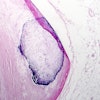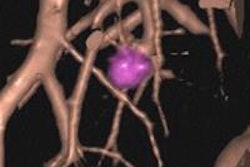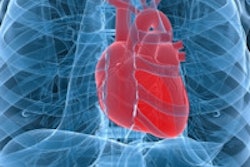Using less iodine, reduced tube voltage, and iterative reconstruction maintains image quality while significantly cutting radiation dose in coronary CT angiography (CCTA) scans, according to a study from researchers in China and the U.S.
In the study of more than 200 patients who underwent CCTA using the combination, radiation dose was reduced by more than one-fourth and contrast by more than one-third -- yet image quality didn't suffer in terms of image noise, contrast-to-noise (C/N) ratio, or signal-to-noise (S/N) ratio, the group reported.
Using 100 kVp, the attenuation increases, enabling the use of lower-concentration contrast, lead author Dr. Bin Lu told AuntMinnie.com.
"At 100 kVp, the noise increases, so we use iterative reconstruction to reduce the noise, and you get beautiful image quality," he said. The method is also robust enough to use in larger patients -- at least by Chinese standards -- with a body mass index (BMI) of up to 30.
Lu and colleagues performed the study at Fu Wai Cardiovascular Institute and Hospital in Beijing. Study co-investigator Dr. Felix Meinel from the Medical University of South Carolina presented the results at ECR 2014 on behalf of Lu and colleagues from the institute and Peking Union Medical College in Beijing.
The combination of low-concentration iodine, 100-kV acquisition, and iterative reconstruction produces comparable image quality to a standard protocol of 120 kV with a standard concentration of contrast medium and filtered back projection. Therefore, radiation dose and iodine load are substantially reduced, Meinel said.
The study included 231 consecutive patients with suspected coronary artery disease, who were scanned with a dual-source CT scanner (Somatom Definition Flash, Siemens Healthcare). The patients were prospectively randomized to one of two CCTA protocols:
- 120 kVp, 370 mgI/mL of iopromide or iopamidol contrast, and filtered back projection data reconstruction (n = 116; 67 men; mean age, 55.3 ± 9.8 years)
- 100 kVp, 270 mgI/mL of iodixanol, and iterative reconstruction (n = 115; 67 men; mean age, 54.2 ± 10.4 years)
The researchers evaluated attenuation and image noise in the ascending aorta and coronary arteries, and calculated S/N and C/N ratios. They also calculated size-specific dose estimates and effective doses.
Two cardiovascular radiologists rated subjective image quality using a four-point scoring system for each coronary segment. A single reader rated objective image quality, and all readers were blinded to the acquisition method, Meinel said.
| CCTA protocols: 120 kV vs. 100 kV | |||||
| Tube voltage | Mean arterial attenuation (HU) |
Image noise (HU) | S/N ratio | C/N ratio | Image quality |
| 120 kV | 406.6 ± 76.7 | 18.7 ± 3.8 | 22.5 ± 5.4 | 37.1 ± 14.7 | 4.1 ± 0.9 |
| 100 kV | 410.6 ± 67.0 | 17.9 ± 3.4 | 23.7 ± 6.1 (p = 0.108) |
38.1 ± 15.2 (p = 0.609) |
4.0 ± 0.9 (p = 0.179) |
The mean iodine dose was 26.5% lower in the 100-kV protocol (18.3 ± 0.5 g) compared to the 120-kV protocol (24.9 ± 0.9 g, p < 0.001). Also, the mean effective radiation dose was 34.9% lower with the 100-kV protocol (2.3 ± 1.0 mSv) compared to the 120-kV protocol (3.5 ± 1.1 mSv, p < 0.0001).
What's interesting about the study is the combination of low tube voltage, reduced iodine dose, and iterative reconstruction, which had not yet been studied with CT angiography, Meinel said.
"We believe that combining these three things is a very logical combination," he said. "Decreasing the tube voltage is very attractive because it reduces dose, and at the same time it increases the iodine attenuation, so that means you can use less iodine to get the same attenuation. The only downside is that it increases image noise, and you can use iterative reconstruction to offset that effect."
Processing the iterative reconstruction data took only "seconds" for each case, he added.
There were a few limitations to the study, he said, principally because the Asian patients generally had lower BMI than Western patients. Patients with arrhythmias and those with heart rates above 90 beats per minute were also excluded.
"And, of course, we evaluated image quality; we did not evaluate diagnostic accuracy -- and we don't have direct evidence that the reduction in contrast medium actually improved renal safety," he said.
Meinel did note that the protocol is robust up to a BMI of 30, which is sufficient for scanning Western patients as long as they are not obese. And there's really no need to use two different kinds of contrast, he added; just reducing the 5-mL/sec flow rate will achieve the same effect.
Lu said the protocol works not only on dual-source CT but on advanced scanner models from all manufacturers, and he has given a number of talks in hospitals across China in hopes of getting them to use the new technique.




















